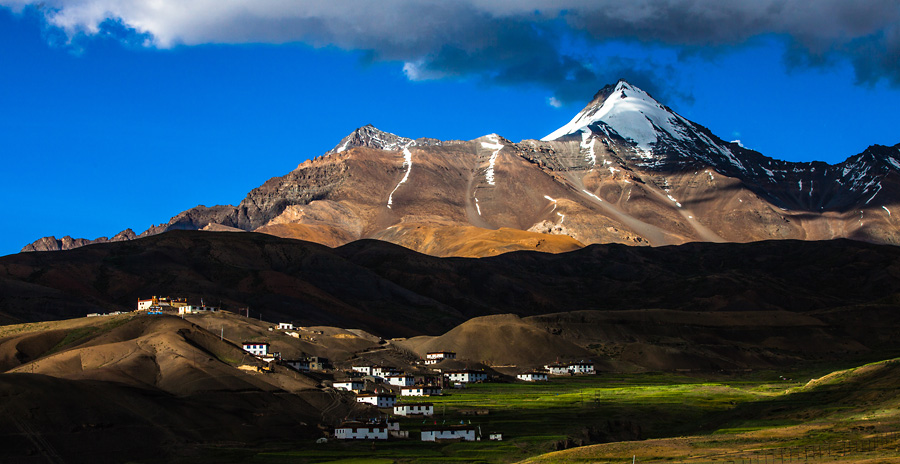
How is it to live in a village at the base of a 20,000 feet high mountain forever covered in snow? How does one endure winter temperatures that can go down to -20C or lower? What is like to be in the company of yaks in summer and snow-leopards in winter? What does it take to survive in such a place for centuries, when modern facilities did not exist? I went to Langza to find answers.

Langza Village, with 6,300m high Chau Chau Kang Nilda Peak in the background.
Langza is no ordinary village. Located above 14,000 feet in Spiti Valley at the crossroads between Tibet and India, where the sun shines strongly over a brown treeless mountainscape in summers, where no rain falls during the monsoons and the winter’s snow can hide your footprints for four months, people have lived for a millennium with little interaction with the outside world. Before the modern world could connect with the people of Spiti, they lived an isolated, nearly self-subsistent life depending on their crop of barley for cereals and livestock for every other needs. They worked hard through the summer months, growing the year’s food and herding their sheep into the high-altitude meadows. The barren winters were for a slower pace of life, for festivities, celebrations and weddings, where barley chang flowed free from a yak-horn cup and the feet moved freely to the rhythm of drums. Only the strongest and the bravest travelled far and wide, to procure salt for the meal and timber for the houses. Everything else was made at home.
In July this year, I spent a week travelling through the high Himalayan region of Lahaul & Spiti in Himachal Pradesh. This was my fourth visit to the region and I was leading a small group of photography enthusiasts with me. Being a regular visitor to these places, I had had some definite ideas about the subjects that I wanted to shoot, the moods that I wanted to portray and also had a fairly good idea about the time of the day that would help me make those images.
In Dhankar Monastery, seen in the photograph, I was keen to portray the remoteness of the place and the precarious location where the monastery stood. I had also realized that the evening light from behind the monastery would help differentiate the crag on which the buildings were located and the high mountains that dominated the landscape behind it. Here is the image I created that evening. The dust rising from behind helped enhance the drama in the scene.

There is, in fact, much more drama than what is seen in the photograph. At the valley just below the monastery is the confluences of Spiti and Pin Rivers, and the view is fabulous from the place where I was shooting. Yet, I decided to exclude that from the frame, since having too many elements of interest may have driven away attention from the main story and would work counterproductive in this situation.
Bridges had fallen and the roads were cut off. A long line of waited for many hours hoping for things to get better. Buses were cancelled and they had no clear answers to when the services will resume. “It depends on the weather, sir,” was the fence-sitting answer from the person manning the phone at the bus company, who neither had any real-time information nor had powers to provide decisive answers.
Himachal Pradesh was seeing heavy rains in the past few days. As it happens every year, landslides had crippled the road infrastructure and there was a cloud of uncertainty over what happens next. Unpredictable as the weather here is, things might magically settle back to normal next morning. Or it could very well turn worse if another line of dark clouds made their way towards the mountains.
My local contact constantly kept me updated on all the information he was able to procure. He had someone or the other in every part of Himachal giving him updates. Yet, nothing seemed certain. I turned to Twitter, looking for all the latest information that one could ask for. I had become like a journalist with a undying fetish for breaking news, scouring for every information that I could get, so that I can make informed decision on our next move.

Chandratal. This is where we were headed before the weather gods made us change plans.
The road from Delhi to Manali was affected by incessant rains that had brought down a bridge at someplace 100km before Manali. Himachal Parivahan had cancelled the night’s bus, since the bus that had left the previous evening from Delhi had not reached Manali yet. Nor did the buses from Manali make it to Delhi. We were stranded in Delhi for a night and were struggling to know the current status, so that we know what to do on the next day. My logistics organizer insisted that we rent a car and just head out, as someone would be working at the bridge and everything would be fine by the time we make the ten hour journey to the point-of-problem.



